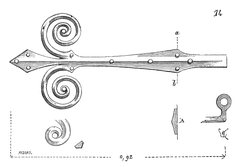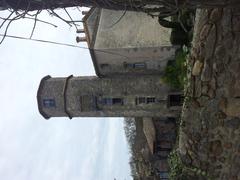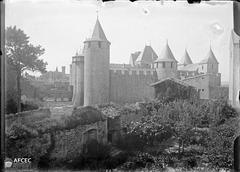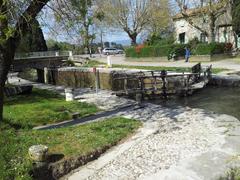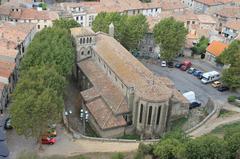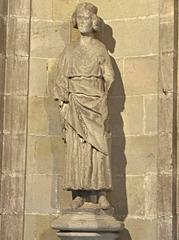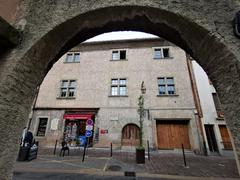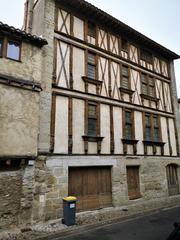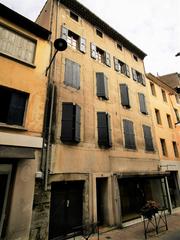Departmental Archives of Aude, Carcassonne: Visiting Hours, Tickets, and Historical Insights
Date: 15/06/2025
Introduction
Situated in Carcassonne—a city celebrated for its UNESCO-listed medieval citadel—the Departmental Archives of Aude safeguard centuries of the region’s documentary heritage. Established in response to the 1838 French law mandating departmental preservation of public records, the archives have evolved into a vital center for historical research and cultural engagement. Their state-of-the-art facility combines innovative architecture with optimal preservation, making it an essential stop for historians, genealogists, and curious travelers alike.
This comprehensive guide provides all the information you need for a rewarding visit to the Departmental Archives of Aude, including opening hours, admission details, accessibility, collections, and visitor tips. It also highlights the archives’ architectural and cultural significance and offers suggestions for exploring Carcassonne’s other historical attractions.
For up-to-date information, consult the Departmental Archives of Aude Official Website, and additional resources like History Tools and EAA – Carcassonne Architecture.
About the Departmental Archives of Aude
Origins and Evolution
The Departmental Archives of Aude were created following the French law of May 10, 1838, which required each department to safeguard its public records. Initially housed in municipal buildings, the archives moved to their first dedicated home in 1937 and then, in 2003, to a purpose-built modern facility designed for both preservation and public access.
Architectural Highlights
Architect Pierre Courtade conceived the current building with a layered “Russian nesting doll” design. The structure uses regional materials—limestone, terracotta, wood, glass, and steel—to harmonize with Carcassonne’s heritage. The archives’ reading rooms offer an inviting space for research, while environmental controls ensure the protection of fragile documents.
What You Can Discover
The Departmental Archives of Aude house a vast array of materials, including:
- Parish and civil registers (1547–1872)
- Notarial and judicial records
- Maps, plans, and architectural drawings
- Private archives from families, businesses, and associations
- Military recruitment and census records
- Photographs, posters, and printed ephemera
Many documents are digitized and accessible via an intuitive online portal.
Visiting Information
Location and Accessibility
- Address: 41 Avenue Claude Bernard, 11855 Carcassonne Cedex 9, France
- Accessibility: The building is fully wheelchair accessible, with ramps, elevators, and adapted restrooms.
- Travel: Easily reached by public transport or car. Parking is available on-site and nearby.
Visiting Hours and Admission
- Monday to Friday: 9:00 AM – 5:00 PM
- Closed: Weekends, public holidays, and annually June 15–30 for maintenance
- Admission: Free for all visitors. No ticket required, but registration at reception is mandatory.
Visitor Registration and Procedures
First-time visitors must present photo ID and complete a registration form. Returning users can sign in with their reader’s card. Bags and coats must be stored in lockers; only pencils, laptops, and notepads are allowed in reading rooms.
Facilities and Services
- Reading Rooms: Spacious, well-lit, with Wi-Fi and power outlets. Staff are available to help with catalog navigation and research.
- Reproduction Services: Photocopies and digital scans are available for a fee, subject to preservation and copyright rules.
- Exhibitions and Guided Tours: Regular exhibitions highlight the region’s history. Guided tours and educational programs are available by appointment.
- Amenities: Restrooms, cloakrooms, and a lounge area. Snacks and drinks via vending machines; cafés and restaurants are nearby.
Digital Resources
- Online Catalogues: Extensive inventories and digitized records available online (Aude Archives Online).
- Remote Research: Digitized parish registers, civil records, census data, and historical maps.
- Research Guides: Step-by-step guides for genealogy and house history research.
- Map Comparison Tools: Interactive map overlays for exploring Carcassonne’s urban evolution (Map Compare Tool).
Collections and Unique Holdings
- Rare Documents: Administrative records from the Ancien Régime and early revolutionary period.
- Historic Maps: Notable maps dating from 1610, 1650, 1787, 1846, 1850, 1893, and 1925.
- Private Collections: Unique family and business archives providing personal perspectives on the region’s past.
Architectural and Cultural Significance
Architectural Context
Located near Carcassonne’s medieval citadel and Bastide Saint-Louis, the Archives’ contemporary design integrates regional materials to reflect the city’s layered history (History Tools). Large windows offer views of Carcassonne’s skyline, while the landscaping uses native Mediterranean plants (EAA).
Interior and Preservation
- Climate-Controlled Vaults: Ensure optimal preservation of fragile documents.
- Functional Spaces: Reading rooms, exhibition galleries, and educational facilities support research and outreach.
- Security: Advanced fire suppression, digitization labs, and surveillance systems protect the collections.
Cultural Role
- Regional Memory: The Archives serve as guardians of Aude’s documentary legacy (History Tools).
- Education and Outreach: Through exhibitions, workshops, and community events (Property Guides).
- Research and Scholarship: Supporting studies on Catharism, the Albigensian Crusade, Occitan culture, and more (EAA).
- Tourism and Economy: Adding depth to Carcassonne’s cultural offerings and boosting local tourism (EAA).
- Symbolic Value: Embodying the continuity of memory and the importance of heritage preservation.
Enhance Your Visit
Visuals and Interactive Media
- Photos: Highlight the exterior (with Carcassonne skyline), reading rooms, and exhibitions.
- Virtual Resources: Online galleries and interactive maps.
- Alt Tags: Use descriptive text such as “Departmental Archives of Aude building in Carcassonne” and “Carcassonne archives reading room.”
Nearby Attractions
- Cité de Carcassonne (medieval fortress)
- Bastide Saint-Louis
- Canal du Midi
- Château Comtal and local museums
See the Carcassonne travel guide for more ideas.
Frequently Asked Questions (FAQ)
Q: Is admission free?
A: Yes, general admission is free. Special events may require registration or a fee.
Q: Can I take photographs in the archives?
A: Photography without flash is usually permitted for personal research. Some restrictions apply.
Q: Are guided tours available?
A: Yes, by appointment. Educational programs are offered for schools and groups.
Q: Is the building accessible for people with disabilities?
A: Yes, the facility is fully accessible.
Q: Is parking available?
A: Onsite and nearby public parking is available.
Q: How do I register?
A: Present photo ID and complete a registration form at reception on your first visit.
COVID-19 and Health Measures
As of June 2025, health protocols such as mask-wearing, social distancing, and hand sanitizing may be in effect. Check the archives’ website before your visit for current requirements.
Accommodation and Dining
Carcassonne offers a range of hotels and guesthouses, especially in Bastide Saint-Louis and near the medieval Cité. Local cafés and restaurants serve regional specialties such as cassoulet and Aude wines. See Carcassonne travel tips for more.
Safety and Security
The archives provide a secure environment with security personnel and CCTV monitoring. Store personal belongings in lockers and report any issues to staff.
Conclusion and Final Tips
The Departmental Archives of Aude are not only a repository of the region’s history but also a dynamic cultural institution offering free admission, expert guidance, and extensive digital resources. Their integration with Carcassonne’s historic landscape makes visiting the archives a highlight for anyone interested in the past.
Tips for a successful visit:
- Check opening hours and any special events in advance.
- Prepare by searching the online catalog and reserving documents if needed.
- Respect preservation guidelines and staff instructions.
- Combine your visit with exploring nearby Carcassonne attractions.
For enhanced research and guided tours, download the Audiala app and follow the archives on social media for news on exhibitions and collections.
Sources and Further Reading
- Departmental Archives of Aude Official Website
- History Tools: Carcassonne – A Fortress City with a Fascinating History
- EAA: Cité de Carcassonne, France
- Property Guides: Discover the Aude
- Carcassonne Tourism Office
- France Archives Portal

